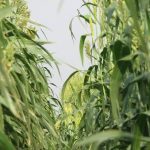Manitoba farmers intend to plant a record-large soybean crop again in 2012, as good returns and improved varieties have led soybeans to gain an ever-larger foothold in the province.
After seeing acreage rise steadily over the past five years, soybean seedings in the province are forecast to hit 800,000 acres in 2012, according to the Statistics Canada planting intentions report released Tuesday.
If realized, that would compare with the previous record for soybeans in the province of 575,000 acres, set in 2011.
Planted area that large would also see Manitoba move ahead of Quebec to be the second-largest soybean-producing province in the country, behind Ontario.
Read Also

Feed Grains Weekly: Price likely to keep stepping back
As the harvest in southern Alberta presses on, a broker said that is one of the factors pulling feed prices lower in the region. Darcy Haley, vice-president of Ag Value Brokers in Lethbridge, added that lower cattle numbers in feedlots, plentiful amounts of grass for cattle to graze and a lacklustre export market also weighed on feed prices.
"We’re adding more and more (soybean) acres into Manitoba every year," said Dennis Lange, a farm production administrator specializing in pulse crops with Manitoba Agriculture, Food and Rural Initiatives in Altona.
Over the winter, he said, the consensus in the market had been for acres in the 700,000 area. He said 800,000 was possible, but noted that weather conditions will need to co-operate at seeding time to reach that level.
Conditions look reasonably good for planting in the soybean-growing regions of the province right now, but the crop won’t be planted for a few more weeks, said Lange.
"The dollar value a farmer gets for growing a soybean crop has been good for producers in Manitoba," he said. Improved varieties that are better suited to Manitoba’s shorter growing season have also done much to increase the interest in planting the crop, he added.
Wet conditions in recent years have helped grow the soybean industry in the province as well, as soybeans fared very well under the excessive moisture, said Lange.
Soybeans were taking some area away from dry beans in the province, especially on the "fringe" edible bean-growing areas, he said.
















